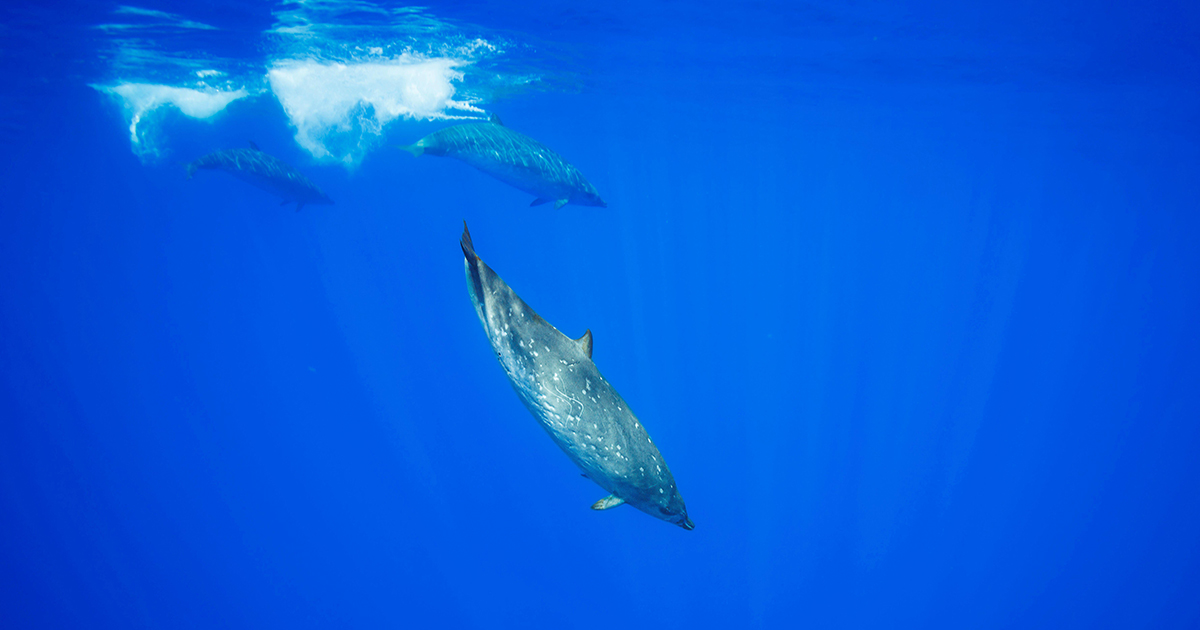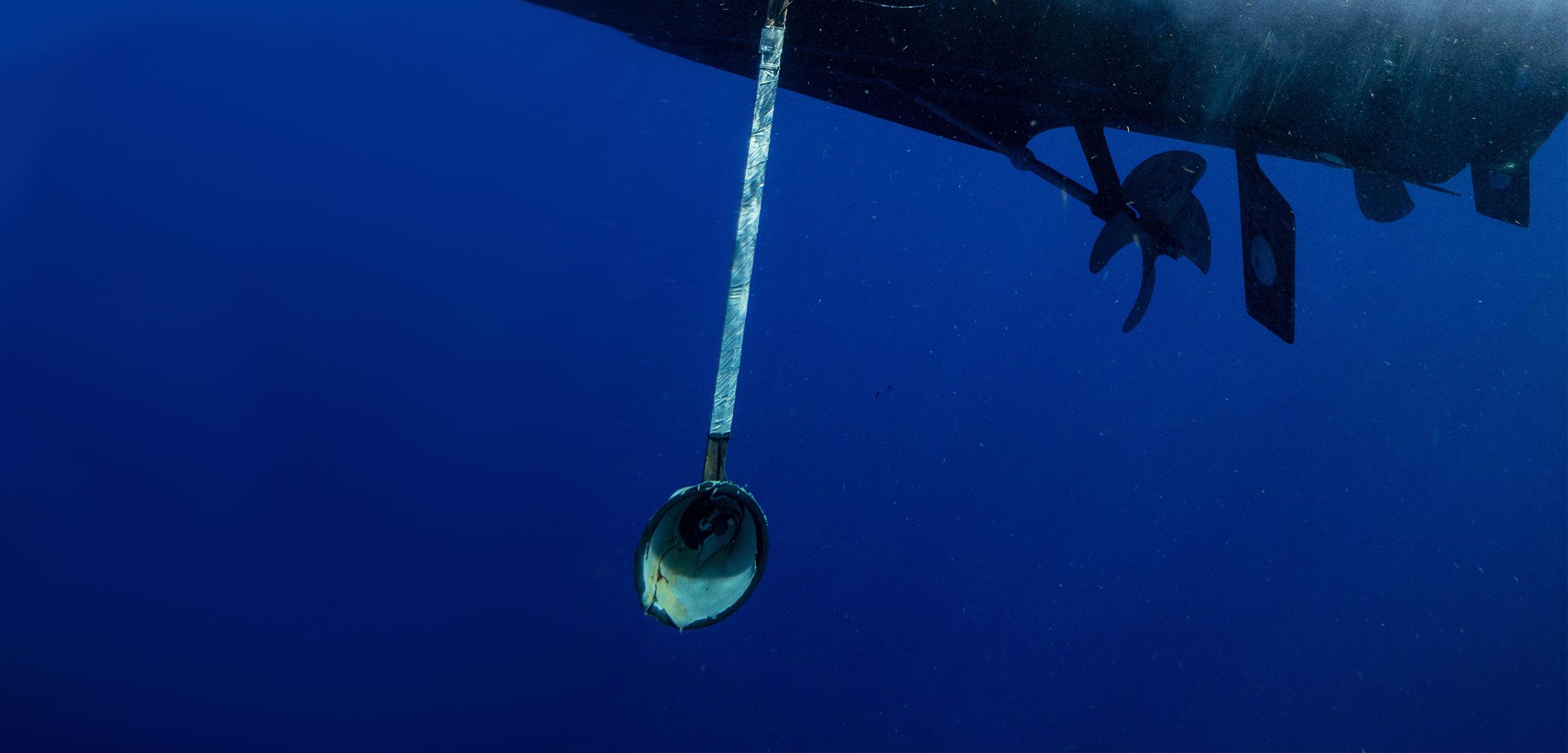The Whale That’s Known Only by the Sound of Its Voice
Scientists have spent 18 years looking for the elusive Cross Seamount beaked whale—a potentially new species they’ve heard but never seen.
Article body copy
The underwater microphone first picked up the distinctive ping around 4:00 a.m. In the water off Hawai‘i, there it was: the unknown whale’s signature call. Jennifer McCullough, a biologist with the US National Oceanic and Atmospheric Administration (NOAA), checks her monitors. From her station on the research ship’s lower deck, her instruments are telling her the sounds are coming from only 200 meters away. She radios up to the bridge, guiding the crew to keep the whales in front of the ship. For 18 years, scientists have been sporadically recording the sounds of this mystery animal. With a bit more light, McCullough might finally, finally, be able to spot one.
Before the sun crests the horizon, a pod of killer whales rolls in. “All the other animals went quiet,” McCullough recalls. The crew follows the killer whales for an hour, hoping they’ll lead them to the mystery whales. No luck.
Scientists have dubbed this enigmatic animal the Cross Seamount beaked whale because it was near the Cross Seamount—an underwater mountain off southwestern Hawai‘i—that they first heard its calls in 2005. Since then, scientists haven’t been quite sure what to make of it. Some think the whale might be a known species—maybe it’s actually the poorly understood ginkgo-toothed beaked whale, an animal understood mostly from strandings. Or maybe, McCullough suggests, it’s a previously undiscovered one: “I’m not taking it off the table,” she says.
The truth is, nobody knows for sure. But McCullough wants to find out. She and her colleagues recently combed through nearly 20 years of recordings of the whale. Like a new fan going through a band’s back catalog, they listened closely. The recordings have convinced biologists the whale is a type of beaked whale—a relative of other deep-water dwellers like the Cuvier’s beaked whale and True’s beaked whale. But its behaviors differ from its cousins.
Globally, there are 24 known species of beaked whales. They range in size from a Honda Civic to a city bus but are all notoriously stealthy. They regularly dive for more than an hour, reaching depths of 3,000 meters. When the whales do surface, they don’t linger. “In a three-hour period, you have maybe 10 minutes where they are at the surface,” says McCullough. To tell the species apart, scientists have to look at the teeth of males; females, even of different species, look nearly identical. Yet, somehow, scientists are still managing to discover new species of beaked whales.

So far as scientists know, nobody has ever seen a Cross Seamount beaked whale—if it’s even a distinct species. Most beaked whales look pretty similar, though, so it probably looks something like the more well-known Blainville’s beaked whale. Photo by David Fleetham/Alamy Stock Photo
Much of what scientists know about beaked whales comes from their calls. Beaked whales echolocate, sending short pulses of sound to bounce off their surroundings. This helps them find prey, mainly squid. Of all the known beaked whales on Earth, every species’ echolocation pulses sound roughly similar: a sweeping, ascending tone. It’s a bit like the noise you get if you run your finger up a guitar string, except it’s so high pitched that it’s inaudible to human ears.
Each species’ call varies slightly, though. The pulses have different frequencies, and the lengths of the calls, and of the pauses in between, change from species to species. Scientists can recognize the profile of each pulse on a computer. “I can look at it and go, Oh, that’s a Cross Seamount, or, Oh, that’s a Blainville’s beaked whale,” McCullough says.
This recording of the Cross Seamount beaked whale has been pitched down to bring it into the range of human hearing. Audio courtesy of Jennifer McCullough/NOAA
McCullough has studied the chatter of many animals, such as polar bears, penguins, and killer whales. “My parents used to joke that I only study black and white animals,” she says. But several years ago, she made an exception for the gray-blue beaked whales. She thought her expertise on animal acoustics could help.
Keen to finally reveal the Cross Seamount beaked whale’s secret identity, McCullough and her colleagues analyzed the recordings collected across the Pacific Ocean. This included clips captured by underwater microphones, called hydrophones, that had been mounted on the seafloor, towed behind vessels, or left to drift freely in the ocean.
Staggeringly, all of these hydrophones—even the one explorer Erden Eruç deployed on an around-the-world rowboat mission—detected the Cross Seamount beaked whale’s signature pulse.
Based on the recordings, McCullough and her colleagues have unlocked some insight into the secretive lives of these whales. For one, they range far beyond the Cross Seamount, stretching from Guam to Mexico. And, of the nearly 24,000 pulses recorded, 92 percent were made at night, with six percent at either sunrise or sunset. By comparison, the well-studied Blainville’s and Cuvier’s beaked whales, which live in the same region, rarely echolocate at night.
Most species of beaked whales also forage at depths of more than 450 meters. But by measuring the angle at which the pulses of Cross Seamount beaked whales hit the hydrophones, the researchers estimated that they forage at much shallower depths than other species.
Robin Baird, a research biologist at the Cascadia Research Collective in Washington State, has worked with McCullough in the past but wasn’t involved in the new work. He says scientists have assumed that all beaked whales share the same behaviors as the well-studied species. “What this study shows is that that’s not necessarily the case,” Baird says. “Cross Seamount beaked whales are doing something different.” The whales’ unique nocturnal foraging makes these already elusive creatures even more slippery.
McCullough hopes that someone will eventually be able to set their sights on one. “I’d love to figure out what species it is,” she says. She’d be happy for someone else to make the identification. “I just want to know.”
So far, the closest a scientist has ever come to seeing a Cross Seamount beaked whale was in 2017. It was swimming south of Hawai‘i’s Big Island near the Cross Seamount, and the sun had set. It was dark enough that the crew of NOAA’s Reuben Lasker research vessel would normally have called it a day, but hydrophone recordings were telling the onboard acoustician the whales were close. They radiod the direction of the sounds up four decks to Suzanne Yin, a species identification expert, who searched from the lookout station at the front of the ship. Through binoculars, Yin scanned the water. She saw a flash of dorsal fin. It was too fast. She cursed as the whale disappeared without revealing any defining features.
And so, the search continues.

